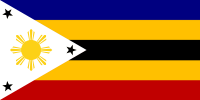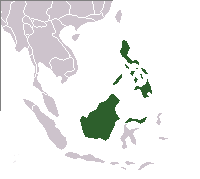Bornei-Filipinas
| Conventional short name: | |
| Local: | Bornei y Filipinas Bornei-Filipinas Filipinas |
| English: | Bornei and the Philippines Bornei-Filipinas The Philippines |

| |

| |
| Cities: | |
| Capital: | Manila City |
| Largest: | Novaliches (part of Metro Manila) |
| Other: | Buayan Binalatoñgan Cebú de Vizaya Cota Bato de Maguindanao Cota Quinabalo Davao Manado Baguio Davao Angeles Iloilo Bacolod Nueva Caceres |
| Languages: | |
| Official: | Chavacano Castilian Tagalog Vizaya Ilocano |
| Others: | Chamorro Maguindanao Malay Palauano Waray Tausug Hiligaynon Bicolano Hokkien |
| Pañghulo: | Rajja Jorge Aliño de Vizaya |
| Prime minister: | Rodrigo Roa Duterte |
| Area: | ... |
| Population: | about 120 million Filipinos and Borneians |
| Established: | 1902, union between Bornei, Maguindanao, the former Castilian protectorate of Sulug, and the former Castilian provinces of the Filipinas and the Malucos. The Malucos, however, left the federation in 1949 |
| Currency: | 1 peso = 8 reales = 24 sueldos = 96 cuartas |
| Organizations: | Castilian Commonwealth of Nations Austronesian League |
The Republic of the Crowns of Bornei and the Filipinas (Castillian: La República de las Coronas de Bornei y las Filipinas), (Chavacano: El República de mañga Coruña de Bornei y Filipinas), (Tagalog: Ang República nañg mga Corona nañg Bornei at Filipinas), or Bornei-Filipinas is a country in insular Southeast Asia.
The archipelago is known for its Christian traditions based on a mixture of Nestorian and Isidorian traditions. The Nestorian tradition was brought over by Nestorian missionaries from China in the 13th century, while the Isidorian tradition came with the arrival of the Castilians. From 1565 and the next 300 years, Castile and Leon tried to colonize the archipelago with mixed success. It did, however, manage to exert a considerable Hispanic influence. For instance, the national language, Chavacano, is a Castilian creole.
Bornei-Filipinas is one of the most influential countries in Asia and was one of the founding members of the Austronesian League.
History
Main article: History of Filipinas
Religion
There is no official religion. The major religions are Borneian Church and the Isidoran Rite Catholics. Both share at least 35% of the population. The Borneian Church is strong in the south and central Luzong; Isidorans, those Filipinos who did not broke from the Catholic church since independence, are numerous elsewhere.
There are also Eastern Orthodox minorities, founded by Father John Maximovitch when he stayed with Russian refugees, both SNORist and anti-SNOR, in Tubabao Island, province of Samar, before finally emigrating to the North American League. They number about 5,324,000 as of the 2020 censue scattered throughout the country, but especially concentrated on Tendaya-Butuan and are politically astute. Muslim Filipinos, called Moros, number about 830,000 in 2020 and stem from the failed attempt by Muslim missionaries to convert Bornei to Islam. They are scattered also throughout the country, but are known in Maguindanao, Sulug, and Bornei. The rest are shared with Protestants (mostly in Lanfang), Buddhists (also majority in Lanfang), and a few Jews.
Language
Chavacano, a Castillian creole, is one of the official languages along with Castillian, Tagalog and Visaya. Chavacano was until recently, the favored national language in Filipinas by the government. It is composed mainly of Zamboanga, Ternate, Ermita, and others, though the Zamboanga and Cavite dialects are the most prominent. The 'Standard' Chavacano usually spoken is the dialect of Ermita, a city in Manila province. It is spoken in the inner parts of Manila province. However, in the south, the Zamboanga dialect predominates. Chavacano is also spoken in Cavite, and in the Province of Ternate (settled by returnees from Cavite).
Tagalog though, seems to challenge or even replace Chavacano as the official language, since this was the language spoken in the outer parts of Manila province. The pervasive influence of Tagalog in other languages, even in Chavacano, as well as the fact that the media in Filipinas are always based in Manila, a Tagalog stronghold, had caused alarm in other regions, and it seems that Chavacano's only role is as a lingua franca of Filipinas. Many of the overseas Filipino communities spoke both Chavacano and Tagalog along with some Castillian, though many also speak Cebuano and Ilocano. Some even argued that Tagalog be designated as the national language on the basis that the Catipunan employed Tagalog rather than Castillian or Chavacano, and Chavacano is really a Romance language creole, not a native Austronesian language.
For this reason, Castillian is used as a working language today in government documents while the Chavacano vs. Tagalog debate continues. As a result, even Vizayans have joined the debate.
In 1965, then-Pañghulo Fernando Marcos declared Vizaya, Ilocano and Tagalog to be co-official alongside Castilian and Chavacano. In addition, a referendum was held on September 1, 2010 approving Bicolano, Capiznon, Waray, Suluano, Malay, Maguindanao and Hokkien among others as additional recognised languages. However, Castillian has remained the working language of government to prevent favoritism. As they are not often used as the languages of government, these additional recognized languages are mostly the common vernaculars of the various rajjaos, and commerce and media are often conducted in them.
Government
The government is a republic. The head of state is called the Pañghulo, usually translated as "President", though in practice essentially an elected monarch as the Pañghulo (theoretically) rules for life. The Pañghulo's powers have been reduced since the fall of the SNORist regime. The Prime Minister governs the day-to-day business of government. In Spanish, he is called the "Presidente del Gobierno", or 'President of the Government', but English writers chose to translate his post into 'Prime Minister' to distinguish him from the Pañghulo, or President.
The legislature is called the Asemblea Nacional. Starting with reforms in the 1990s, the Asemblea had become bicameral. The lower house is called the Camara de Representantes, representing provinces and certain minority and special groups, and the Senado, which is composed of both majarlicas from the Rajjaos and certain non-majarlica senators elected at-large. The majarlica senators are elected for a life-term unless they resign; the non-noble ones are elected every six years, renewable for two terms. Many derided the non-majarlica system of electing senators as a way to compete with the majarlica senators and the majarlica senators tend to be more respected, because the majarlicas are prohibited from joining any political party.
Geography
Bornei-Filipinas is an archipelago consisting of more than 7,200 islands. It consists of the islands of the Filipinas Archipelago, (which include the Rajjaos of Cabolohan, Luzoñg, Vizayas, Tendaya-Butuan and Mindanao); the eastern portions of Micronesia, (which include the Rajjaos of the Marianas and Palao); the northern arm of Celebes, (which belongs to the Rajjao of Manado); and Bornei, (which belongs to the Majarajjao of Bornei and the Rajjao of Sulug).
The boundaries of the rajjaos compared to the provinces and regions *here* are as follows:
- The Commonwealth of Cumintang is the Tagalog-speaking rajjao. It is mix of Catholics and Borneian Church with a Protestant minority.
- The Majarajjao of Bornei is the rajjao in north central Bornei. The population is mostly of the Borneian Church, as the head of the Church resides there.
- The Rajjao of Manado consists of the part of Sulawesi north of the equator, plus the Talaud and Sangir archipelagos of *here*. Capital at Manado.
- The Rajjao of Maguindanao is a rajjao in central Mindanao; the whole island was named after this polity, and their people, the Maguindanao. Its capital is Maraui. It is staunchy Borneian Church with sizeable Catholic, Protestant, and Muslim minorities.
- The Rajjao of Sulug is a rajjao mainly inhabited by the Tausug people. While majority Borneian Church, it has a Catholic and Muslim minority.
- The State of Ilocandia is composed of the northernmost Filipino provinces and is majority Borneian Church. The capital is in Vigan.
- The Rajjao of Vizaya is composed of the Cebuano, Ilonggo, and Bicolano regions. Capital at Cebu. The population is majority Catholic.
- The Ginhadian of Tendaya is said to be the remnant of SNORist Filipinas along with Ilocandia, as it was populated with Orthodox converts. Unusually, it was friendly with majority Borneian Church Ilocandia, due to Fernando Marcos the Second's ties with the Tendayan royal family of Romualdez.
- The Majarajjao of Luzoñg is mostly composed of the Kapampangan and northern Tagalog people. The population is majority Borneian Church with a significant Catholic and Protestant minority.
- The Rajjao of Cabolohan consists of the provinces of Pangasinan, La Union, Benguet, the Mountainous Provinces, and Zambales. The capital is in Binatalongan, Pangasinan. The population is a mix of Catholics and Borneian Church.
- The Mariana Islands, officially the Reino de Chamorros claims Castellano Guam as part of its territory. The population is majority Catholic. Capital at Saipan.
- The Rajjao of Palao consists of the Palao island chain. It is the smallest of the Rajjaos. It is majority Catholic. The capital is Coror.
- The Kongsi Federation of Lanfang is composed of mostly Sangley (Chinese) people in western Bornei island. This is the majority Buddhist rajjao, and is also the most Protestant part of the country, as most Christian Sangley converts there were converted from Scandinavian and Scottish missionaries instead of the Church of the East and Catholics.
The country is further subdivided into Provinces, each of which is subject to a rajjao (though in practice they are mostly subordinate to the rajjao governments rather than the rajja themselves).
Sport
Basketball is essentially the national sport in Filipinas much like *here*, though with better successes in the international championships *there*. It was introduced by American Protestant missionaries in the Philippines and despite the religious differences, it proved to be popular among all groups. Battlegame is also a favored game in Filipinas, so much so that some "unofficial" matches use plastic pellets or even live ammunition in all cases, discouraged by the ABFB [the official Battlegame organization in Filipinas], but it is always ignored.
Sepac Tacraw is the official sport, played also in Mazapahit and Xrivizaja.
Football is played in Filipinas, but Filipinas has the unfortunate reputation of being among the poorest-performing national football teams in the world much like *here*. Basketball's sheer popularity in Filipinas caused Filipino football to be mostly ignored. However, dedicated fan clubs and players exist to ensure the survival of Bornei-Filipinas in football. This is not enough to warrant inclusion in the World Football Series and Bornei-Filipinas had withdrawn from two qualifying tournaments due to perennial failures of the national team.
Military
The Armed Forces of Filipinas was founded in 1898 by combining the armies of Filipinas and Bornei. While it initially enjoyed considerable strength thanks to influx of SNORist Russian weaponry, after the Bornei Filipinas War, its strength whittled away, its equipment badly needed replacement.
In 2010, Prime Minister Benigno Simeon Aquino announced an overhaul of military forces. Army forces received new Austrian AUG rifles, the Navy got two new frigates, and the Air Force received new jet aircraft and airships from Japan.